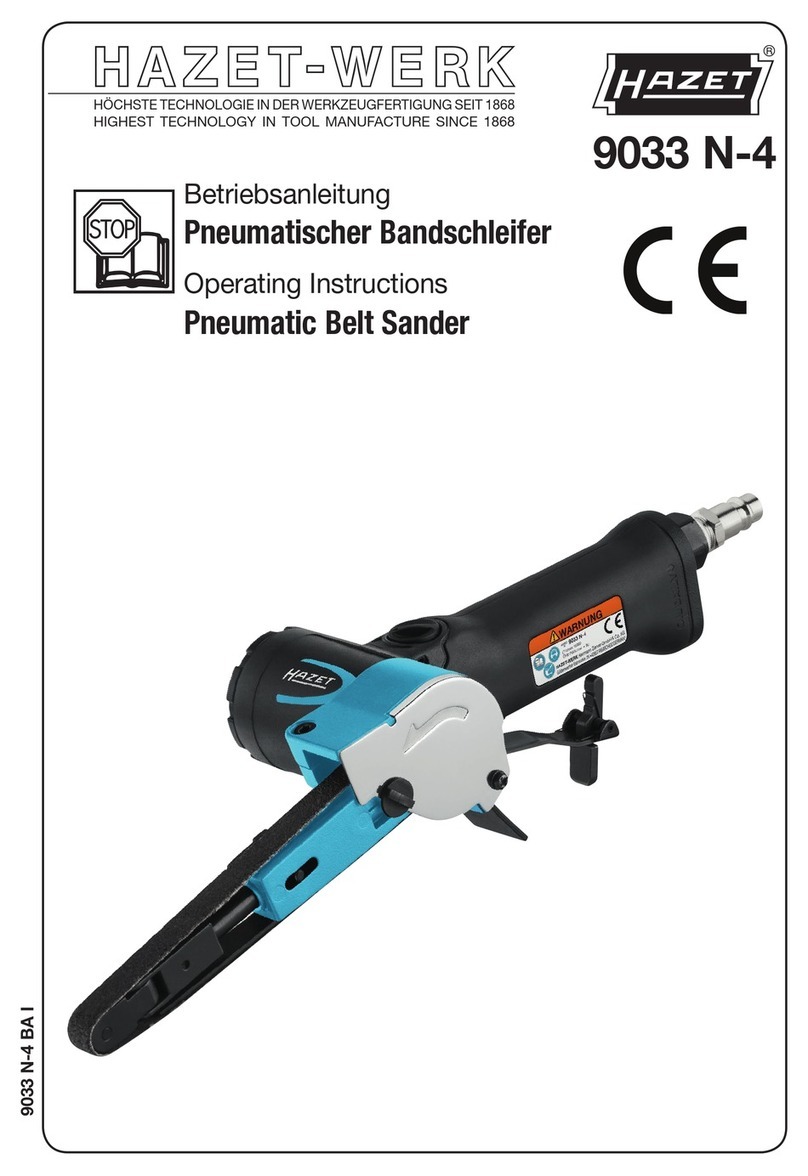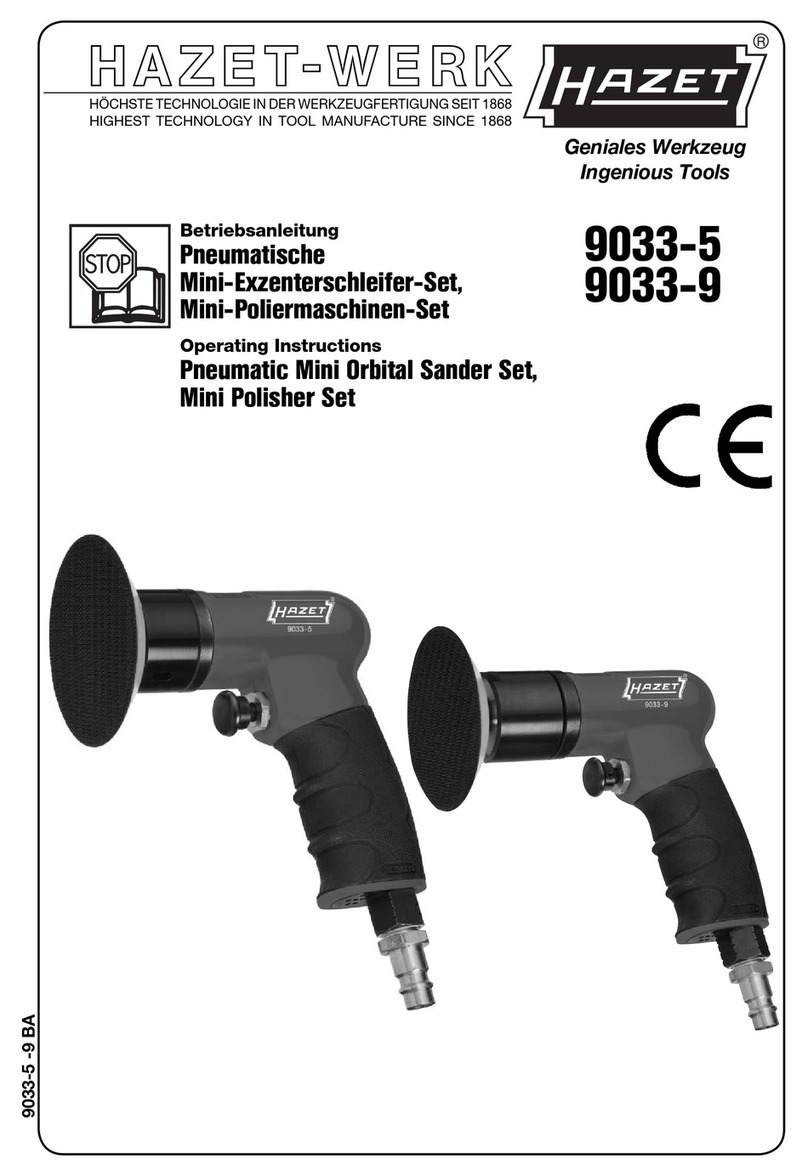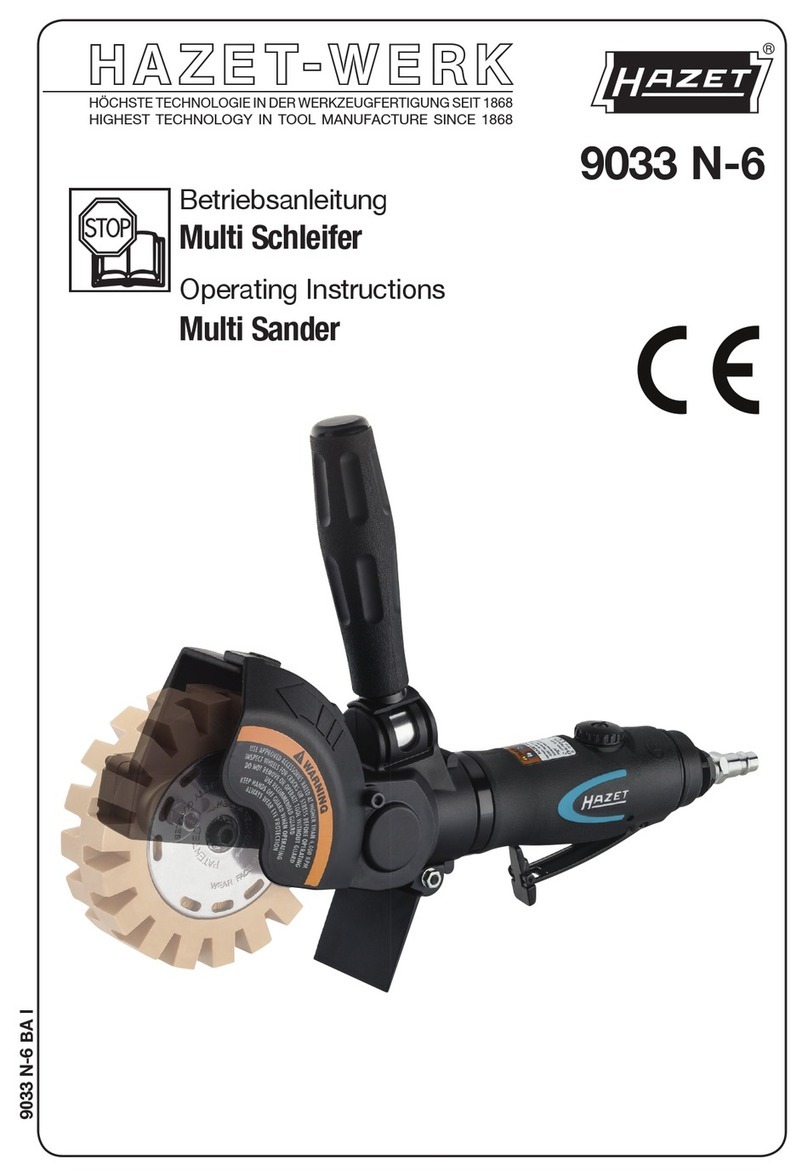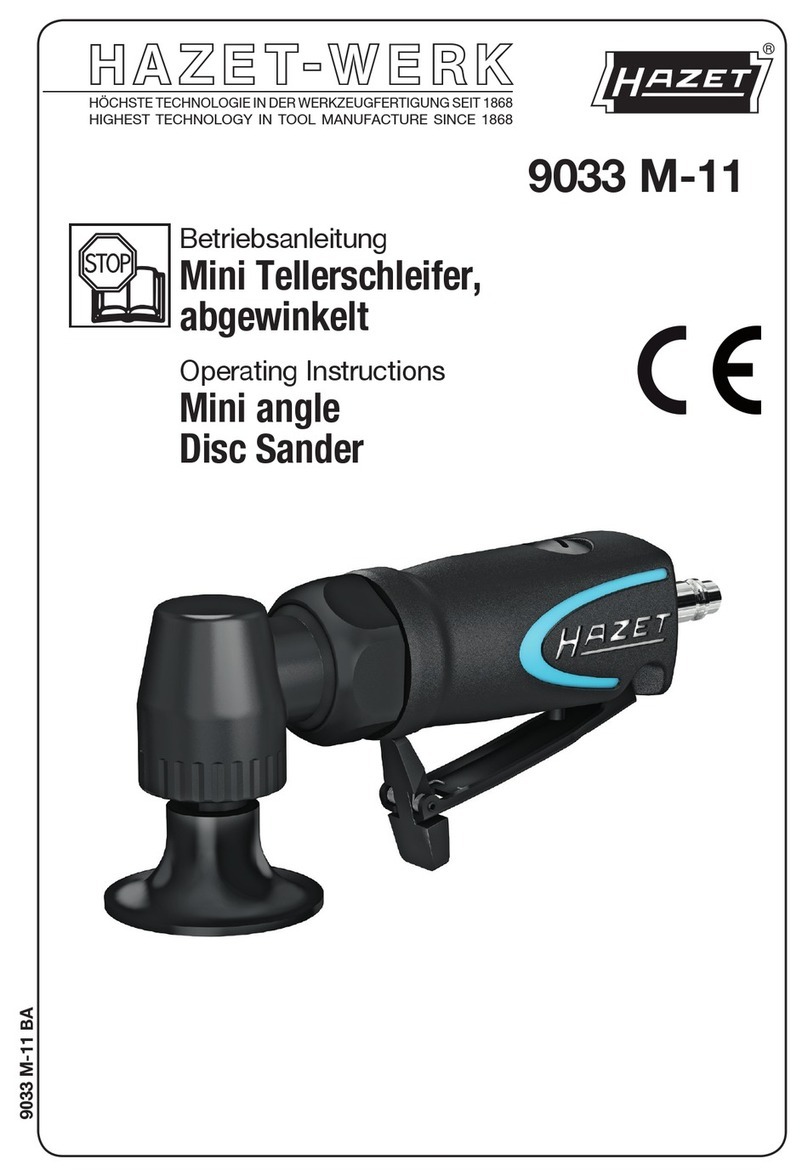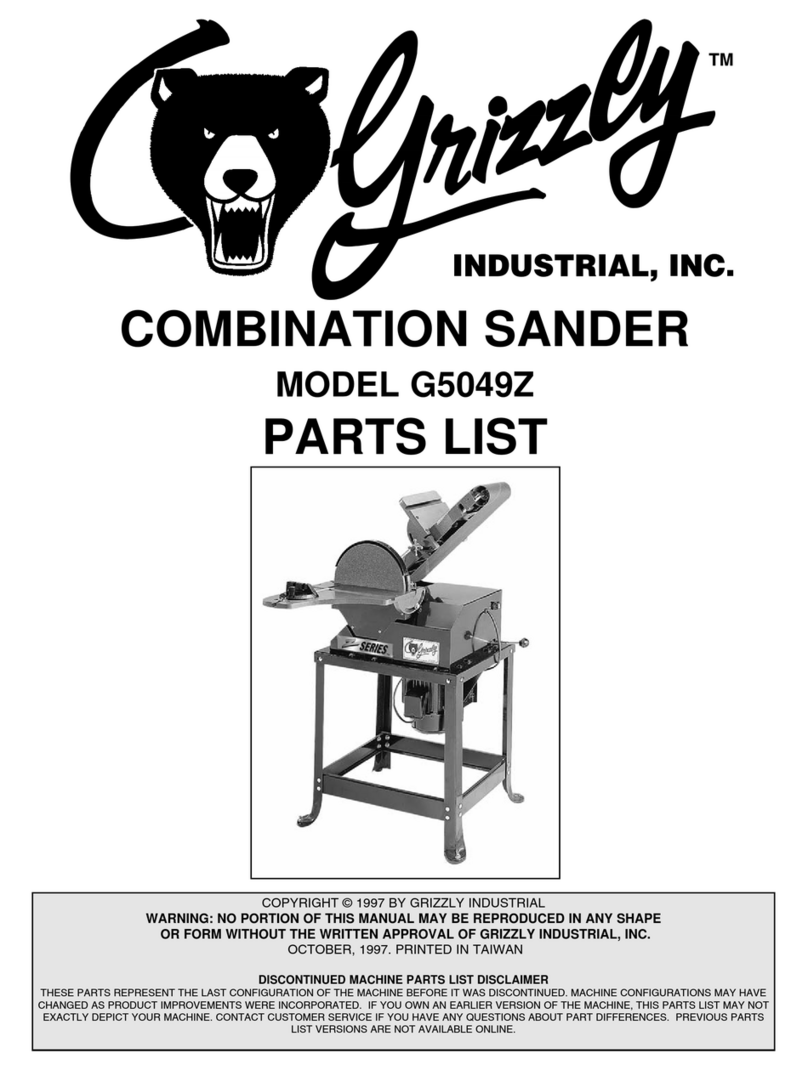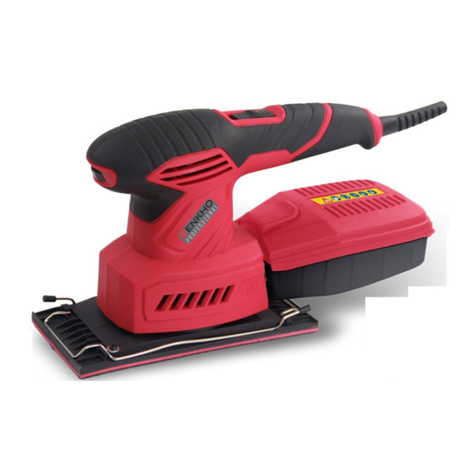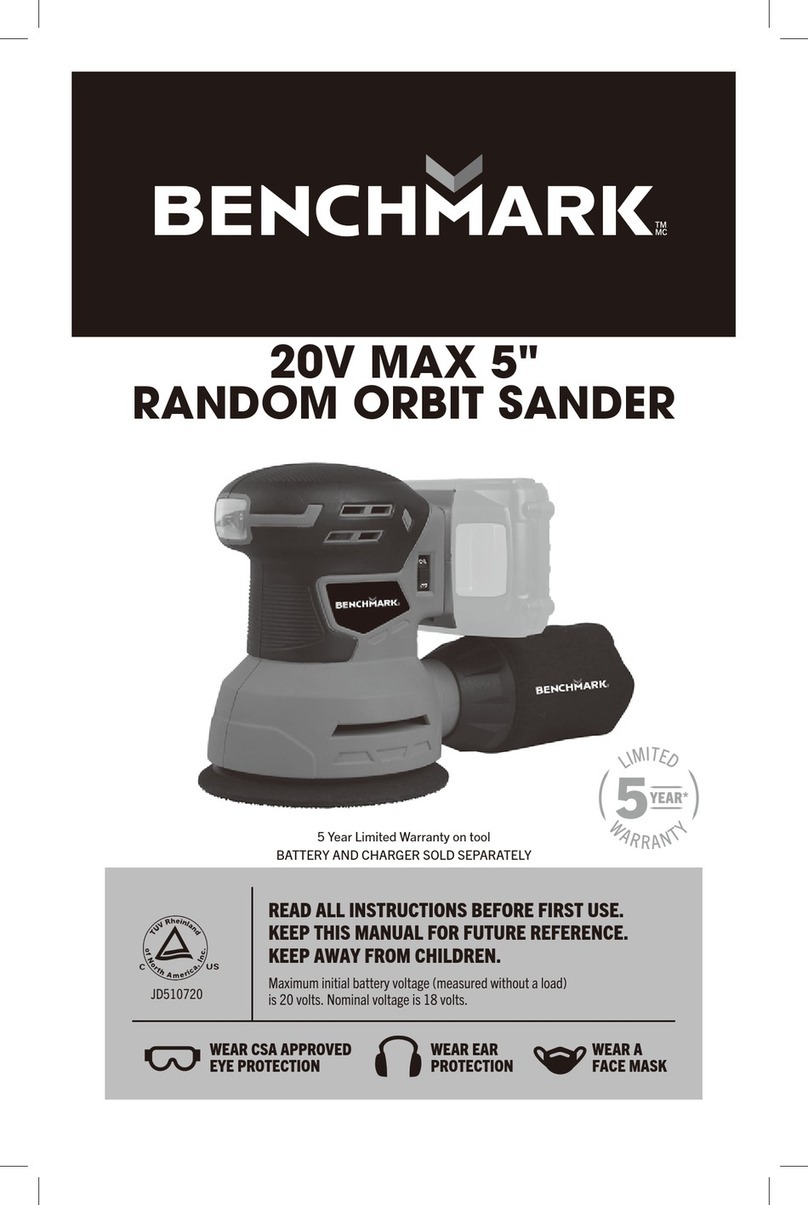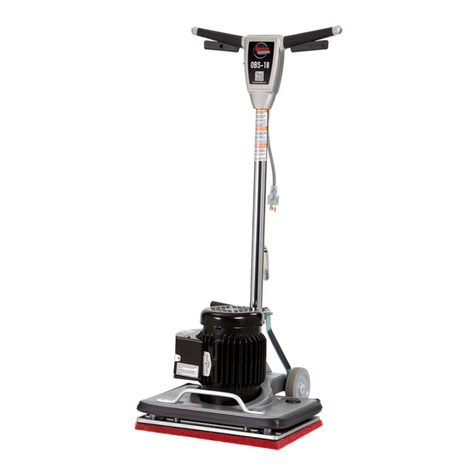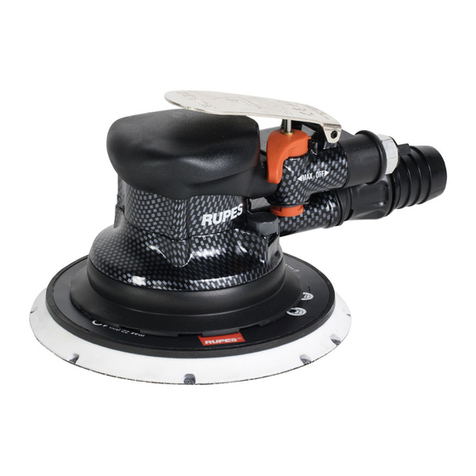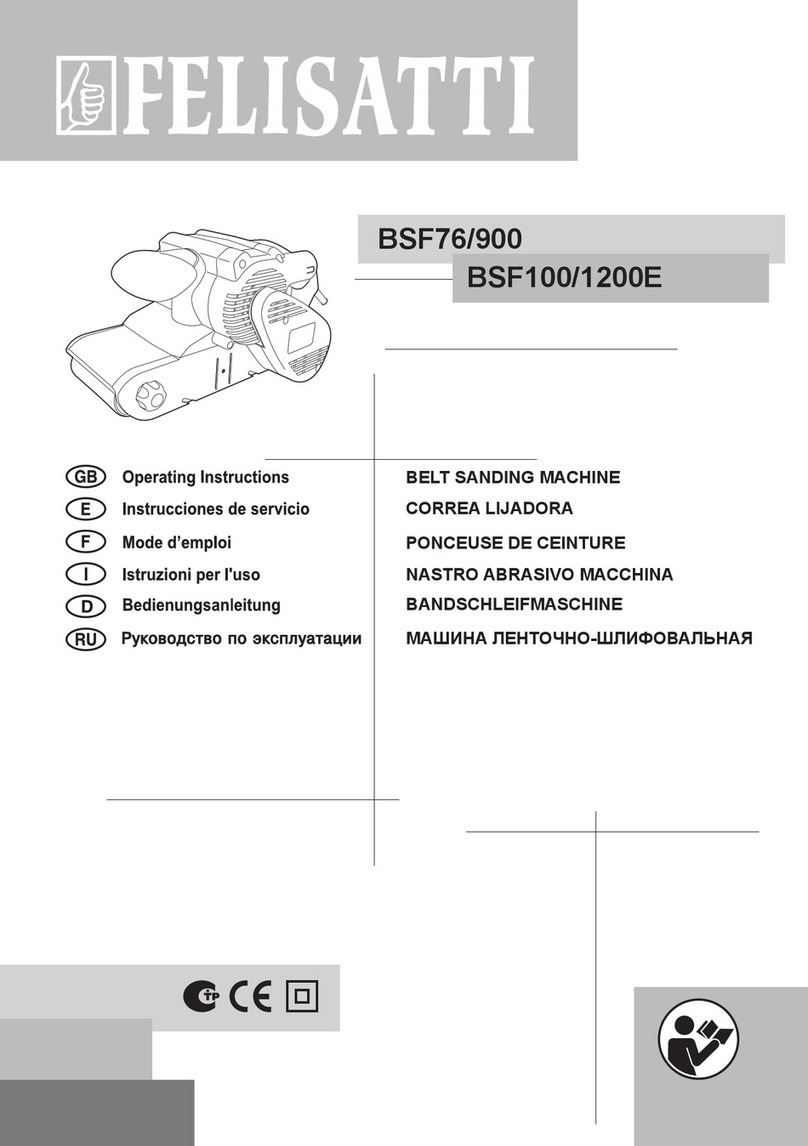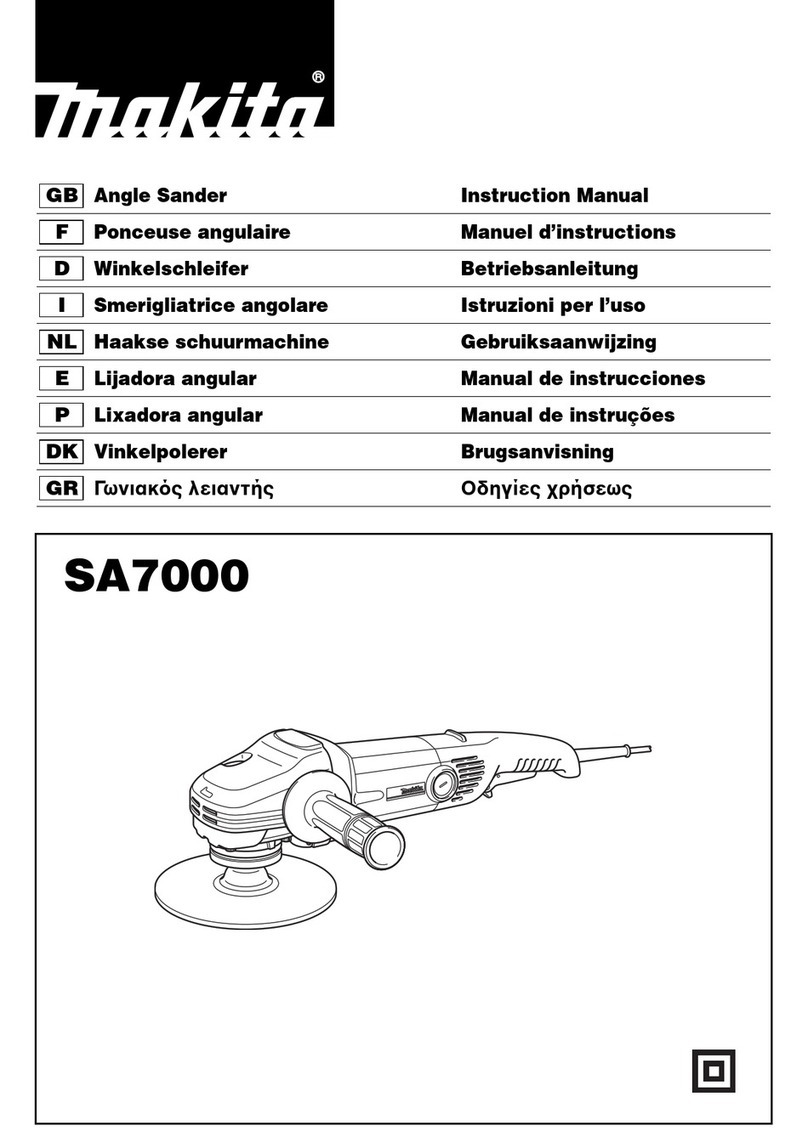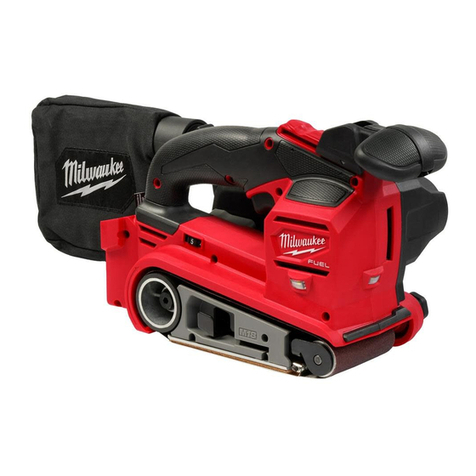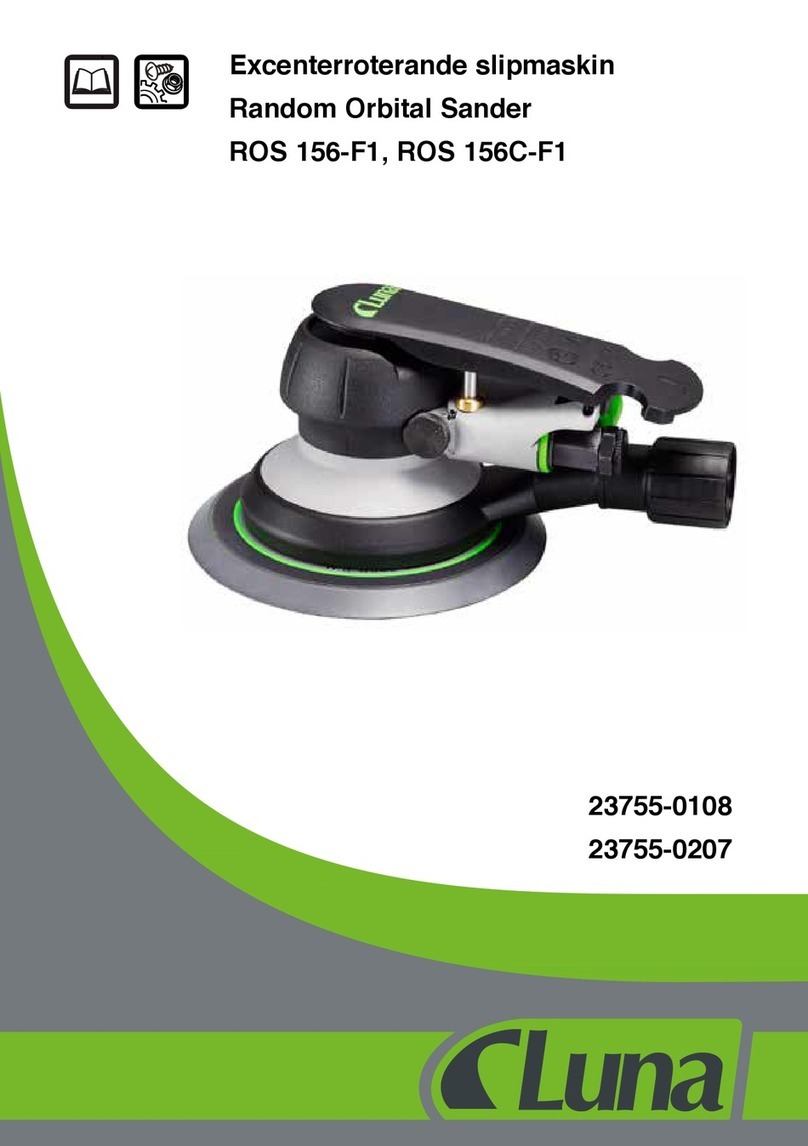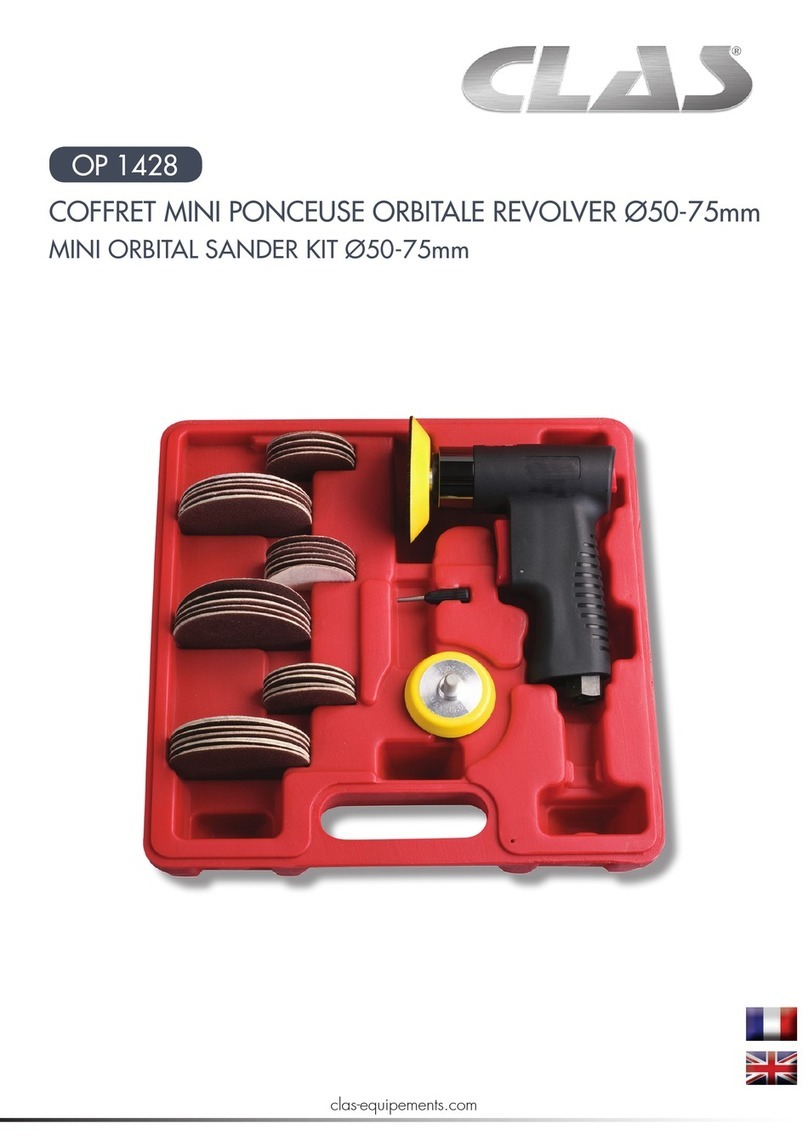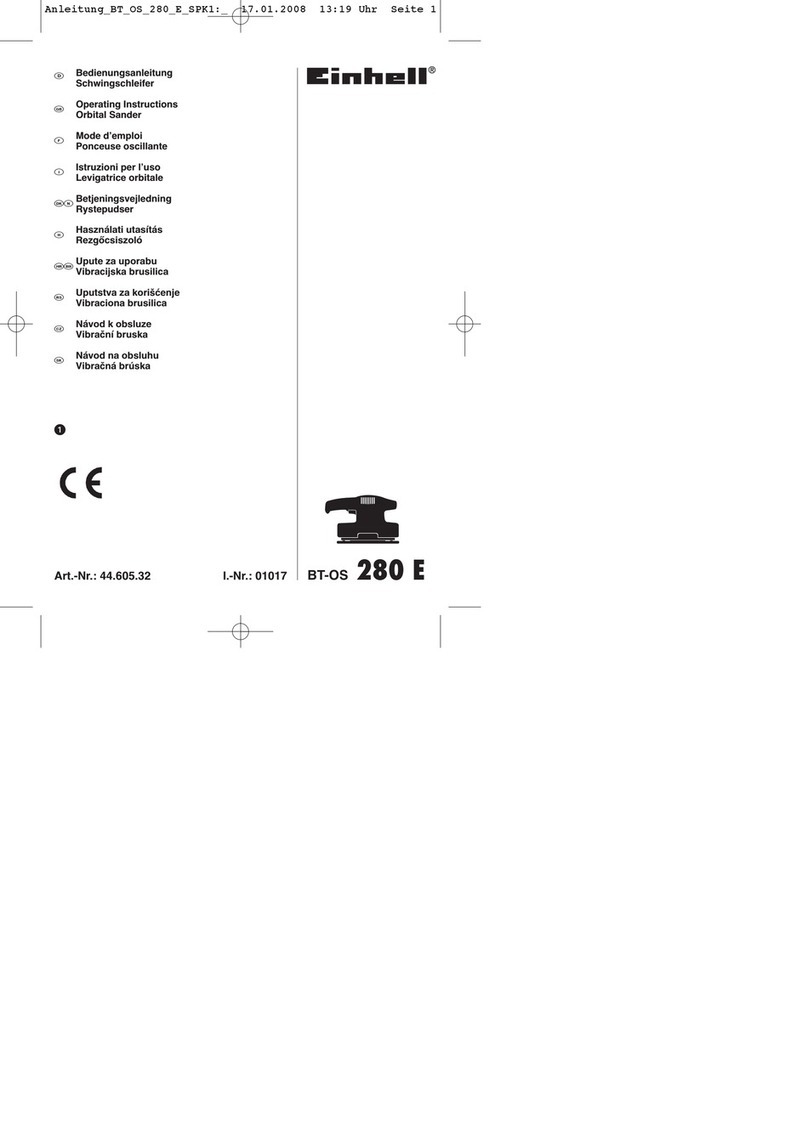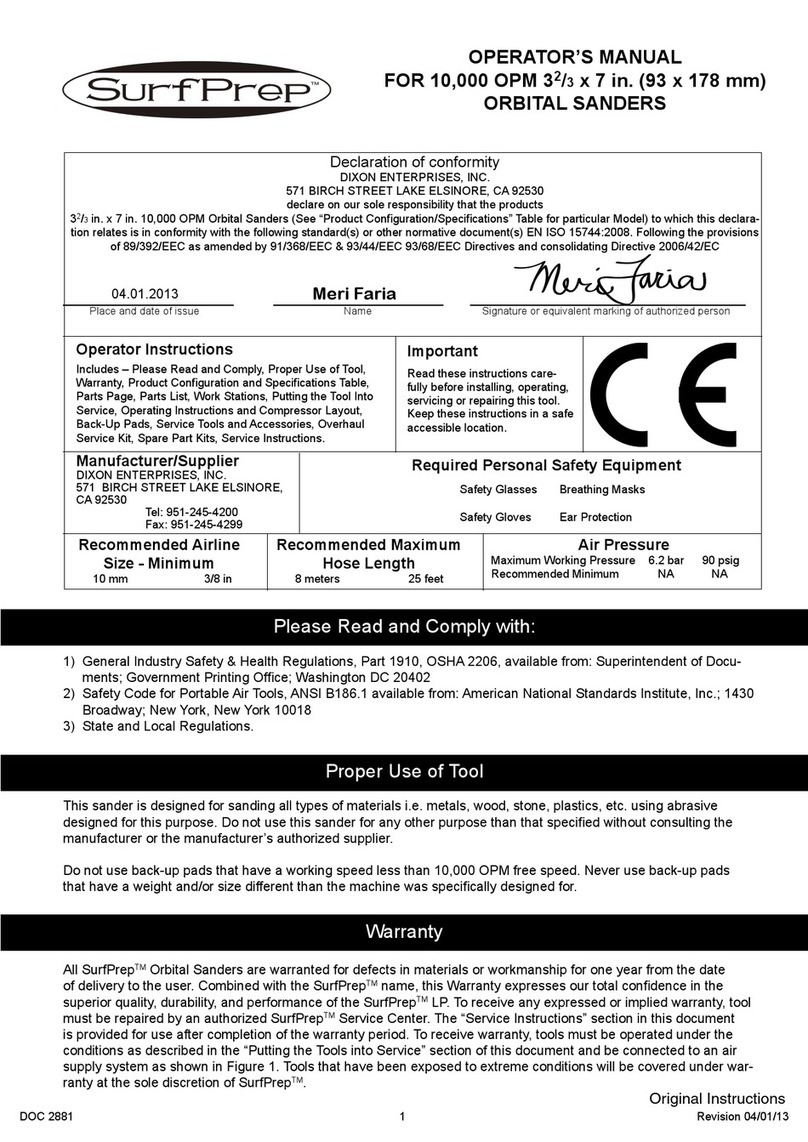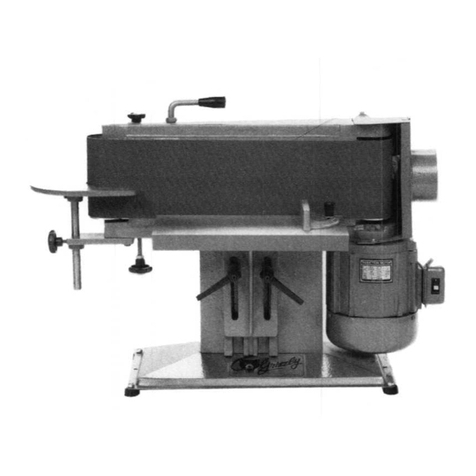Hazet 9033 N-5 User manual

9033 N-5
9033 N-9
HAZET-WERK
HÖCHSTE TECHNOLOGIE IN DER WERKZEUGFERTIGUNG SEIT 1868
HIGHEST TECHNOLOGY IN TOOL MANUFACTURE SINCE 1868
Betriebsanleitung
Pneumatische
Mini-Exzenterschleifer-Set,
Mini-Poliermaschinen-Set
Operating Instructions
Pneumatic Mini Orbital Sander Set,
Mini Polisher Set
9033 N-5 -9 BA

2
HAZET-WERK Hermann Zerver GmbH & Co. KG
} 10 04 61 · 42804 REMSCHEID · GERMANY · [ +49 (0) 21 91 / 7 92-0
\ +49 (0) 21 91 / 7 92-375 (National) · \ +49 (0) 21 91 / 7 92-400 (International)
^ hazet.de · ] [email protected]
......... ............. 3 ... 10
......... ............ 11 ... 18
Ursprungsprache deutsch – original language: German – Langue d’origine allemand

3
1Zu Ihrer Information
1. Allgemeine Informationen
• Bitte stellen Sie sicher, dass der Benutzer
dieses Werkzeugs die vorliegende Betriebs-
anleitung vor der ersten Inbetrieb nahme
gründlich durchgelesen und verstanden hat.
• Diese Betriebsanleitung enthält wichtige
Hinweise, die zum sicheren und störungs-
freien Betrieb Ihres HAZET-Werkzeuges
erforderlich sind.
• Zum bestimmungsgemäßen Gebrauch
des Werkzeuges gehört die vollständige
Beachtung aller Sicherheitshinweise und
Informationen in dieser Betriebsanleitung.
• Bewahren Sie deshalb diese Betriebs an lei-
tung immer bei Ihrem HAZET-Werkzeug auf.
• Dieses Werkzeug wurde für bestimmte
An wendungen entwickelt. HAZET weist
ausdrücklich darauf hin, dass dieses
Werkzeug nicht verändert und/oder in einer
Weise eingesetzt werden darf, die nicht
seinem vorgesehenen Verwendungs zweck
entspricht.
• Für Verletzungen und Schäden, die
aus unsach gemäßer, zweckentfrem-
deter und nicht bestimmungsgemäßer
Anwendung bzw. Zuwiderhandlung gegen
die Sicherheitsvorschriften resultieren,
übernimmt HAZET keine Haftung oder
Gewährleistung.
• Darüber hinaus sind die für den Einsatz-
bereich des Werkzeugs geltenden
Unfallverhütungs vorschriften und allgemei-
nen Sicherheits bestimmungen einzuhalten.
2. Symbolerklärung
ACHTUNG:Schenken Sie diesen Symbolen
höchste Aufmerksamkeit!
Betriebsanleitung lesen!
Der Betreiber ist verpflichtet die
Betriebsanleitung zu beachten und
alle Anwender des Werkzeugs gemäß
der Betriebsanleitung zu
unterweisen.
HINWEIS!
Dieses Symbol kennzeichnet
Hinweise, die Ihnen die Handhabung
erleichtern.
WARNUNG!
Dieses Symbol kennzeichnet wich-
tige Beschreibungen, gefährliche
Bedingungen, Sicherheitsgefahren
bzw. Sicherheitshinweise.
ACHTUNG!
Dieses Symbol kennzeichnet Hinwei-
se, deren Nichtbeachtung Beschä-
digungen, Fehlfunktionen und/oder
den Ausfall des Gerätes zur Folge
haben.
FACHLEUTE!
Werkzeug nur für die Verwendung
durch Fachleute geeignet,
Handhabung durch Laien kann zu
Verletzungen oder Zerstörung des
Werkzeugs oder des Werkstücks füh-
ren.
Gehörschutz tragen!
Wear hearing protection!

4
2. Bestimmungsgemäße
Verwendung
Die Betriebssicherheit ist nur bei bestim-
mungs gemäßer Verwendung entsprechend
der Angaben in der Betriebsanleitung
gewährleistet. Neben den Arbeitssicherheits-
Hinweisen in dieser Betriebsanleitung sind die
für den Ein satz bereich des Gerätes allgemein
gültigen Sicherheits-, Unfallverhütungs- und
Umwelt schutz-Vorschriften zu beachten und
einzuhalten.
Die Benutzung und Wartung muss immer
entsprechend den lokalen staatlichen Landes-
oder Bundes bestim mungen erfolgen.
• Der HAZET-Pneumatik-Minischleifer dient
zur Bearbeitung von Schweißnähten sowie
zur Lack- und Rostentfernung.
• Der HAZET Mini Polierer dient insbesondere
zum Polieren von engen begrenzten oder
kleinen Flächen, wie Sicken und Kanten,
Säulen innen, etc.
• Der unsachgemäße Gebrauch des HAZET-
Pneumatik-Werkzeugs oder der Gebrauch
nicht entsprechend der Sicherheitshinweise
kann zu schweren Verletzungen oder zum
Tode führen.
• Jede über die bestimmungsgemäße
Verwen dung hinausgehende und/oder
andersartige Verwendung der Geräte ist
untersagt und gilt als nicht bestimmungsge-
mäß.
• Ansprüche jeglicher Art gegen den Hersteller
und/oder seine Bevollmächtigten wegen
Schäden aus nicht bestimmungsgemäßer
Verwendung der Geräte sind ausgeschlos-
sen.
• Für alle Schäden bei nicht
bestimmungsgemäßer Verwendung haftet
allein der Betreiber.
1. Verantwortung
des Betreibers
• Das Gerät ist zum Zeitpunkt seiner Ent-
wick lung und Fertigung nach geltenden,
anerkannten Regeln der Technik gebaut
und gilt als betriebssicher. Es können
vom Gerät jedoch Gefahren ausgehen,
wenn es von nicht fachgerecht ausgebil-
detem Per sonal, unsachgemäß oder nicht
bestimmungsgemäß, verwendet wird.
Jede Per son, die mit Arbeiten am oder mit
dem Gerät beauftragt ist, muss daher die
Betriebsanleitung vor Beginn der Arbeiten
gelesen und verstanden haben.
• Veränderungen jeglicher Art sowie An- oder
Umbauten am Gerät sind untersagt.
• Alle Sicherheits-, Warn- und Bedienungs-
hin weise am Gerät sind stets in gut les-
barem Zustand zu halten. Beschädigte
Schil der oder Aufkleber müssen sofort
erneuert werden.
• Angegebene Einstellwerte oder -bereiche
sind unbedingt einzuhalten.
• Betriebsanleitung stets in unmittelbarer
Nähe des Geräts aufbewahren.
• Gerät nur in technisch einwandfreiem und
betriebssicherem Zustand betreiben.
• Sicherheitseinrichtungen immer frei er -
reich bar vorhalten und regelmäßig prüfen.
2Zu Ihrer Sicherheit
Gehörschutz tragen!
Wear hearing protection!

5
3. Gefahren die vom
Gerät ausgehen
Vor jeder Benutzung ist das HAZET-Werkzeug
auf seine volle Funk tions fähigkeit zu prüfen. Ist
die Funk tions fähig keit nach dem Ergebnis die-
ser Prüfung nicht gewährleistet oder werden
Schäden festgestellt, darf das Werkzeug nicht
verwendet werden. Ist die volle Funktions-
fähigkeit nicht gegeben und das Werkzeug
wird dennoch verwendet, be steht die Gefahr
von erheblichen Kör per-, Ge sund heits- und
Sach schäden.
• Keine Werkzeuge verwenden, bei denen der
Ein-/Aus-Schalter defekt ist. Werkzeuge, die
nicht mehr mit dem Ein-/Aus-Schalter ein-
bzw. ausgeschaltet werden können, sind
gefährlich und müssen repariert werden.
• Alle Service- oder Repara turarbeiten immer
durch Fachpersonal ausführen lassen. Um
die Betriebssicherheit auf Dauer zu gewähr-
leisten, dürfen nur Originalersatzteile ver-
wendet werden.
• Schutzvorrichtungen und/oder Gehäuseteile
dürfen nicht entfernt werden.
• Betätigen Sie das Werkzeug nie, wenn eine
Schutzabdeckung fehlt oder wenn nicht alle
Sicherheitseinrichtungen vorhanden und in
einwandfreiem Zustand sind.
• Aus Sicherheitsgründen sind Verän der-
ungen an HAZET-Werkzeugen untersagt.
Die Vornahme von Veränderungen am Gerät
führt zum sofortigen Haftungs ausschluß.
• Arbeitshandschuhe und
Schutzbrille tragen.
Werkzeuge mit pneuma-
tischem Antrieb können
Späne, Staub und anderen
Abrieb mit hoher Geschwin-
digkeit aufwirbeln, was zu
schweren Augenver letz-
ungen führen kann. Druckluft
ist gefährlich. Der Luftstrom
kann empfindliche Körper-
teile wie Augen, Ohren
etc. schädigen. Vom Luftstrom aufgewir-
belte Gegenstände und Staub können zu
Verletzungen führen.
• Gehörschutz tragen. Lange
Belastung durch die Arbeits-
geräusche eines Druckluft-
werk zeuges kann zum dau-
erhaften Gehörverlust führen.
• Gesichtsmaske oder
Atemschutz tragen. Einige
Materialien wie Klebstoffe
und Teer enthalten Chemi-
kalien, deren Dämpfe, über
einen längeren Zeitraum
eingeatmet, schwere
Schädigungen verursachen können.
• Enganliegende Arbeitsschutzkleidung tra-
gen. Werkzeuge mit bewe-
genden Teilen können sich in
Haaren, Kleidung, Schmuck
oder anderen losen Gegen-
ständen verfangen, was zu
schweren Verletzungen füh-
ren kann. Tragen Sie niemals zu weite und/
oder mit Bändern oder Schlaufen etc. verse-
hene Kleidung, die sich in den bewegenden
Werkzeugteilen verfangen kann. Legen Sie
bei der Arbeit sämtlichen Schmuck, Uhren,
Identifikations marken, Armbänder, Hals-
ketten etc. ab, die sich am Werkzeug verfan-
gen könnten. Fassen Sie niemals Werkzeug-
teile an, die in Bewegung sind. Lange Haare
sollen zusammengebunden oder bedeckt
werden.
• Druckluftwerkzeuge gehören nicht in
Kinderhände. Unbeaufsichtigte oder an die
Druckluftzufuhr angeschlossene Werkzeuge
können von nicht autorisierten Personen
benutzt werden und zu deren oder zur
Verletzung dritter Personen führen.
2Zu Ihrer Sicherheit
Gehörschutz tragen!
Wear hearing protection!

6
• Gerät nicht in explosionsgefährdeten
Räumen verwenden. Werkzeuge wie
Schleifer können Funkenschlag verur-
sachen, der zur Entzündung brennbarer
Materialien führen kann. Werkzeuge nie
der Nähe von brennbaren Substanzen wie
Benzin, Naphtha oder Reinigungsmitteln etc.
betätigen. Nur in sauberen, gut gelüfteten
Bereichen arbeiten, in denen sich keine
brennbaren Materialien befinden. Niemals
Sauerstoff, Kohlendioxid oder andere in
Flaschen abgefüllte Gase zum Antrieb von
Druckluftwerkzeugen verwenden.
• Gerät nicht auf andere Personen richten.
Bei Betrieb des Werkzeuges Kinder und
andere Personen aus dem Arbeitsbereich
fernhalten.
• Gerät nicht im Leerlauf betreiben.
• Druckluftwerkzeuge dürfen nicht in
Kontakt mit Stromquellen kommen.
• Auf Betriebsdruck achten, max. Luftdruck
siehe Tabelle Seite 7. Das Überschreiten des
zulässigen Maximaldrucks von Werkzeugen
und Zubehörteilen kann Explosionen ver-
ursachen und zu schweren Verletzungen
führen. Der Maximaldruck der Druckluft
muss gleich oder unterhalb der zulässigen
Druckbelastungsangaben der Schleifer lie-
gen.
• Schlauchverbindung auf festen Sitz prü-
fen. Keine schadhaften Druckschläuche
verwenden. Umherschlagende Druck-
schläuche können zu schweren Verletzungen
führen.
• Druckluftwerkzeuge nur im drucklosen
Zustand abklemmen. Umherschlagende
Druckschläuche können zu schweren
Verletzungen führen.
• Nur trockene, saubere Luft verwen-
den. Verwenden Sie niemals Sauerstoff,
Kohlendioxid oder andere in Flaschen
abgefüllte Gase zum Antrieb von
Druckluftwerkzeugen.
• Verwenden Sie nur vom Hersteller emp-
fohlene Ersatzteile, Befestigungen und
Zubehör.
• Das Werkzeug niemals am Druckluft-
schlauch tragen.
• Das angeschlossene Werkzeug niemals
mit dem Finger am Betätigungshebel
tragen.
• Unbeabsichtigte Betätigung vermeiden.
• Griffe immer trocken, sauber, öl- und fett-
frei halten.
• Achten Sie auf einen sauberen, gut gelüf-
teten und stets gut beleuchteten Arbeits-
bereich.
• Das Werkzeug niemals unter Alkohol-
oder Drogeneinfluss benutzen.
• Reparaturen nur von autorisierten
Personen durchführen lassen.
•Kennzeichnung des Gerätes muss
immer gut lesbar sein. Der Bediener ist
dafür verantwortlich, dass die Plakette
mit Warnhinweis, Drehzahl, Serien- und
Artikel-No. unbeschädigt und gut lesbar
ist.
•Verwenden Sie Schnellkupplungen nie
direkt am Gerät. Die Schnellkupplung
muss durch mindestens 20 cm
Luftschlauch vom Gerät getrennt sein.
•Schleifteller nur bei abgekuppeltem
Luftschlauch auswechseln.
•Zum Austausch der Schleifpads das
Werkzeug immer von der Druckluftzufuhr
lösen, Sicherheitshinweise beachten.
•Nur die für das Gerät vorgesehenen
Schleifpads verwenden.
2Zu Ihrer Sicherheit
Gehörschutz tragen!
Wear hearing protection!

7
1. Technische Daten / Geräteelemente
9033 N-5 9033 N-9
Luftanschluß Gewinde mm (˝) 6,3 (1⁄4) 6,3 (1⁄4)
Schleifteller
x
mm 50/75 75
Schleifpads/Polierschwamm
x
mm 50/75 75
Schleifpads Körnung 320, 400, 600 -
Schleifhub / Exzentrizität mm 4
Max. Leerlauf-Drehzahl U/min 15.000 3.200
Leistung PS 0,32 0,32
Watt 238 238
Gewicht kg 0,64 0,72
Empf. Schlauchquerschnitt mm 10 10
Luftverbrauch l/min 79 91
Betriebsdruck bar 6,3 6,3
Schall-Druckpegel dB(A) 80 85,76
Schall-Leistungspegel dB(A) 93 96,76
Vibrationsbeschleunigung m/s20.77 2.43
Geräte-Abmessungen mm
107 x 150 x 41 116 x 150 x 41
2. Lieferumfang
9033 N-5: Set im Koffer
Mini-Exenterschleifer,
1 Schleifteller 50 mm,
1 Schleifteller 75 mm,
10 Schleifpads 50 mm, Körnung 320,
10 Schleifpads 50 mm, Körnung 400,
10 Schleifpads 50 mm, Körnung 600,
10 Schleifpads 75 mm, Körnung 320,
10 Schleifpads 75 mm, Körnung 400,
10 Schleifpads 75 mm, Körnung 600,
Schlüssel zur Montage/Demontage
des Schleiftellers
9033 N-9: Set im Koffer
Mini-Polierer,
1 Schleifteller 75 mm,
1 Lammfell,
1 Gelber Polierschwamm,
1 Weißer Polierschwamm,
Schlüssel zur Montage/Demontage
des Schleiftellers
3Aufbau und Funktion
Gehörschutz tragen!
Wear hearing protection!

8
• Die technischen Daten des Werkzeugs
beziehen sich auf den Betrieb bei einem
Druck von 6.3 bar.
• Beim Gebrauch der Schleif-, Poliermaschine
ist immer Vorsicht geboten. Bei nachläs-
sigem Betrieb können Innenteile oder das
Gehäuse beschädigt und die Arbeitsleistung
eingeschränkt werden.
• Zur Betätigung des Werkzeugs
Betätigungshebel drücken.
• Zum Stoppen des Werkzeugs Betätigungs-
hebel loslassen.
• Beachten Sie, dass das Werkzeug nach
Loslassen des Betätigungshebels noch
nachläuft.
• Nach beendeter Arbeit Kompressor aus-
schalten und gemäß der Kompressor-
Gebrauchsanweisung lagern.
• Nur trockene, saubere Luft mit ca. 90 PSI
oder 6.3 bar Maximaldruck verwenden.
Staub, brennbare Dämpfe und eine zu hohe
Feuchtigkeit können den Motor eines pneu-
matischen Werkzeugs zerstören.
• Entfernen Sie keine Plaketten, ersetzen Sie
beschädigte Plaketten.
• Halten Sie Hände, weite Kleidung und
lange Haare vom sich bewegenden Teil des
Werkzeugs fern.
3. Vor Inbetriebnahme
Die Benutzung, Inspektion und
Wartung von Pneumatik-Werk-
zeugen muss immer entspre-
chend der lokalen, staatli-
chen Landes- oder Bundes-
bestimmungen erfolgen.
• Kompressortank entwässern und Kondens-
wasser aus den Luftleitungen entfernen.
Lesen Sie die Gebrauchsanweisung für den
Kompressor ebenfalls gründlich durch.
WICHTIG:
Die Verwendung von Luftfiltern und
eines Druckluft-Leitungsölers ist zu
empfehlen.
ACHTUNG!
Vor dem Ölen, Anschließen oder
Abkoppeln des Werkzeuges, die
Druckluft-Zufuhr unterbrechen.
• Werkzeug ölen, siehe Wartung in dieser
Gebrauchsanweisung.
• Entfernen Sie die Staubkappe am Druckluft-
Einlaß.
• Schließen Sie das Werkzeug an einen
Schlauch passender Größe an.
Tabelle Seite 7.
4. Inbetriebnahme
• Schalten Sie den Kompressor ein, so dass
sich der Lufttank füllen kann.
• Stellen Sie den Kompressorregler auf ca. 90
PSI oder 6.3 bar. Der maximale Betriebs-
druck dieses Werkzeugs liegt bei ca. 90 PSI
oder 6.3 bar.
• Die Drehleistung kann abhängig von der
Größe des Luftkompressors und des
Volumens des Druckluft-Ausstoßes variie-
ren.
• Verwenden Sie keine beschädigten, abge-
nutzten oder minderwertigen Luftschläuche
oder Verbindungsstücke.
• Die Druckregelung zum Erreichen der rich-
tigen Werkzeug-Geschwindigkeit erfolgt
über den Kompressor-Regler, bzw. einen
extra zu montierenden Druckregler.
• Die Regelung der Geschwindigkeit erfolgt
mit einem Luftzufuhr-Regler (nicht im
Lieferumfang enthalten).
3Aufbau und Funktion
Gehörschutz tragen!
Wear hearing protection!

9
ACHTUNG!
Überschüssiges Öl im Motor wird
sofort durch den Luftauslass ausge-
stoßen.
WARNUNG!
Auslassöffnung nie auf Menschen
oder Objekte richten. Der Luftauslass
befindet sich hinten am Handgriff.
• Wartung
Vor der Durchführung von Wartungs-
arbeiten das Gerät immer von der
Druckluft-Zufuhr lösen.
Bei täglicher Nutzung ist vierteljährlich eine
Wartung durchzuführen, spätestens jedoch
nach 1000 Betriebsstunden.
Beschädigte oder abgenutzte Bauteile wie
O-Ringe, Lager etc. sind zu ersetzen und
alle beweglichen Teile zu ölen.
Es sind ausschließlich vom Hersteller emp-
fohlene Ersatzteile zu verwenden, andern-
falls erlischt die Gewährleistung.
Bitte achten Sie bei der Entsorgung von
Einzelteilen, Schmiermitteln etc. darauf,
dass die entsprechenden Richtlinien zum
Umweltschutz eingehalten werden.
Zur Reinigung des Werkzeugs oder sei-
ner Einzelteile wird der Gebrauch von
Waschbenzin empfohlen.
Reinigen Sie nie mit Lösungsmitteln oder
Säuren, Estern (organischen Verbindungen
aus Säuren und Alkohol), Aceton (Keton),
Chlorkohlenwasserstoffen oder nitrokar-
bonathaltigen Ölen. Verwenden Sie keine
Chemikalien mit niedrigem Flammpunkt.
Für die Inanspruchnahme des Kunden-
dienstes setzen Sie sich bitte mit Ihrem
Händler oder dem HAZET-Service Center in
Verbindung.
6. Störungen
Bei Störungen bitte Prüfen:
• Kompressionsanlage und Druckluft-
Zuleitung Luftverbrauch l/min und Schlauch-
querschnitt entsprechend den technischen
Daten des Gerätes
• Betriebsluft auf Staub und Rostanteile sowie
Kondensat untersuchen
• Überölung des Luftmotors
Mini
-Exenter
schleifer:
• Drücken Sie das Schleifpapierpad
auf den Schleifteller.
Prüfen Sie das Schleifpapierpad auf festen
Sitz.
• Achten Sie darauf, dass der Mini-
Exenterschleifer bei der Arbeit nur leicht
angedrückt wird!
• Schleifteller wechseln:
Die Kunststoff Absaugabdeckung lösen
und mit dem mitgelieferten Flachschlüssel
die Spindel am Sechskant fixieren. Den
Schleifteller gegen den Uhrzeigersinn
abschrauben. Neuen Schleifteller aufsetzen
und im Uhrzeigersinn handfest aufschrau-
ben.
Polierer:
• Wählen Sie das Werkzeug gemäß dem
Anwendungsfall aus.
• Den Luftdruck prüfen und ggf. so einstel-
len, dass der Betriebsdruck erreicht wird.
Siehe Tabelle Seite 7.
5. Wartung und Pflege
• Ölen:
Druckluft-Werkzeuge müssen während
ihrer gesamten Lebensdauer geölt werden.
Der Motor und die Kugellager benötigen
Druckluft, um das Werkzeug anzutreiben. Da
die Feuchtigkeit in der Druckluft den Motor
rosten lässt, muss der Motor täglich geölt
werden. Hierfür ist die Verwendung eines
integrierten Ölers zu empfehlen.
• HAZET 9070-1 Öler zur Montage am
Pneumatik-Werkzeug.
• Ölen des pneumatischen Motors von
Hand:
Werkzeug von der Luftzufuhr abkoppeln
und mit dem Lufteinlass nach oben halten.
Ein bis zwei Tropfen Spezial-Druckluftöl in
den Lufteinlass geben.
Werkzeug an die Druckluftzufuhr
anschließen, Luftauslass am Werkzeug
mit einem Handtuch abdecken und einige
Sekunden laufen lassen.
Für das Ölen des Werkzeugs nie brennbare
oder leicht verdampfbare Flüssigkeiten wie
Kerosin, Diesel oder Benzin verwenden.
3Aufbau und Funktion
Gehörschutz tragen!
Wear hearing protection!

10
• Aus Sicherheitsgründen dürfen nur Original-
Ersatzteile des Herstellers verwendet werden.
• Falsche oder fehlerhafte Ersatzteile können
zu Beschädigungen, Fehlfunktionen oder
Totalausfall des Werkzeuges führen.
• Bei Verwendung nicht freigegebener Ersatzteile
erlöschen sämtliche Garantie-, Service-,
Schadensersatz- und Haftpflichtansprüche
gegen den Hersteller oder seine Beauftragten,
Händler und Vertreter.
• Zur Aussonderung, reinigen und unter
Beachtung geltender Arbeits- und
Umweltschutzvorschriften zerlegen.
• Bestandteile der Wiederverwertung zuführen.
• Das Gerät ist unter folgenden Bedingungen
zu lagern und aufzubewahren:
• Nicht im Freien aufbewahren.
• Trocken und staubfrei lagern.
• Keinen Flüssigkeiten und aggressiven
Substanzen aussetzen.
• Lagertemperatur -10 bis +45°C.
• Relative Luftfeuchtigkeit max. 65%
4Ersatzteile
5Aufbewahrung / Lagerung
6Entsorgung
Gehörschutz tragen!
Wear hearing protection!

11
1. General information
• Please make sure that the user of this tool
carefully reads these operating instructions
and fully understands all information given
before it is used.
• These operating instructions contain impor-
tant advice that is necessary for safe and
trouble-free operation of your HAZET tool.
• For effective use of the tool as intended, it is
essential that all safety and other informati-
on in these operating instructions is adhered
to.
• For this reason, always keep these opera-
ting instructions together with your HAZET
tool.
• This tool has been designed exclusively for
specific applications. HAZET emphasizes
that any modification to the tool and/or use
on an application that does not correspond
to its intended application are strictly forbid-
den.
• HAZET will not be liable for any injuries to
persons or damage to property originating
from improper or inappropriate application,
misuse of the tool or a disregard of the safe-
ty instructions.
• Furthermore, the general safety regulations
and regulations for the prevention of acci-
dents in the application area of this tool
must be observed and respected.
2. Explanation of symbols
ATTENTION: Pay strict attention to these
symbols!
Read the operating instructions!
The owner of this tool is obli-
ged to observe the operating
instructions and ensure that all
users of this tool use it accor-
ding to the operating instructions.
NOTE!
This symbol indicates advice that is
helpful when using the tool.
WARNING!
This symbol indicates important spe-
cifications, dangerous conditions,
safety risks and safety advice.
CAUTION!
This symbol indicates advice which
if disregarded results in damage,
malfunction and/or functional failure
of the tool.
QUALIFIED PERSONNEL!
Tool may be used by qualified
personnel only. Handling by non-
qualified people may lead to injuries
to persons or damage to the tool or
the workpiece.
1For Your Information
Gehörschutz tragen!
Wear hearing protection!

12
2For Your Safety
2. Intended use
Operational reliability is only guaran-
teed if the tool is used as intended in accor-
dance with the information in the operating
instructions. In addition to the safety advice in
these operating instructions, the general safe-
ty regulations, regulations for the prevention
of accidents and regulations for environmental
protection valid for the application area of this
tool have to be observed and respected.
Always ensure that the use and maintenance
of the tool complies with relevant local and
national regulations.
• The HAZET pneumatic mini sander is used
for processing weld seams and for remo-
ving paint and rust.
• The HAZET mini polisher is especially suited
to polishing very limited or small surfaces
such as creases and edges, insides of pil-
lars etc.
• Any incorrect use of the HAZET pneumatic
tool or use that fails to comply with the safe-
ty instructions can result in serious injury or
even death.
• Any deviation from the intended use and/or
any misapplication of the tools is not allo-
wed and will be considered improper use.
• Any claims against the manufacturer and/
or its authorised agents because of damage
caused by improper use of the tools are
void.
• Any personal injury or material losses
caused by improper use of the tool are the
sole responsibility of the owner.
1. Operator's
responsibility
• This tool was developed and manufactured
according to the technical norms and stan-
dards valid at the time and is considered
to be operationally reliable. Nevertheless,
the tool can present a danger when it is
not used as intended or in an inappropriate
way by non-qualified personnel. Please
make sure that any person using this tool
or carrying out maintenance work carefully
reads these operating instructions and
fully understands all information provided
before using the tool.
• Any modification of the tool is strictly for-
bidden.
• All safety warning and operating instruc-
tions on the tool must be kept legible at
all times. Immediately replace all damaged
labels or stickers.
• All indications concerning setting values
and setting ranges must be observed.
• Always keep the operating instructions
close to the tool.
• The tool must only be used if it is in good
working condition.
• All safety equipment must always be within
easy reach and should be checked regularly.
Gehörschutz tragen!
Wear hearing protection!

13
3. Dangers that may arise
from the tool
Before each use, check the HAZET tool for full
functionality. Do not use the tool if its functio-
nal efficiency cannot be ensured or if damage
is detected. If it is determined that the tool is
not in good working order but the tool is used
in spite of this, there is a danger of serious
damage to body, health and property.
• Do not use tools with a defective on/off
switch. Any tools that cannot be switched on
or off with the On/Off switch are dangerous
and must be repaired immediately.
• All service or repair work must be carried out
by qualified personnel only. Only use original
spare parts in order to guarantee its long
term operational safety.
• Do not remove safety tools / guards and/or
housing parts.
• Never operate the tool if a protective cover is
missing or if one or more of the safety tools
/ guards are not fitted and in perfect conditi-
on.
• For safety reasons any modification of
HAZET tools is strictly forbidden. Any modi-
fication of the tool will result in immediate
exclusion from express or implied warranty
and liability.
•Wear working gloves and
safety glasses.
Pneumatic tools can disper-
se chips, dust and other
abraded particles at high
speed which may result
in severe eye injuries.
Compressed air is dan-
gerous. The air flow may
cause harm to sensitive parts
of the body such as eyes,
ears, etc. Dust and objects
being raised by the air flow
may cause injuries.
• Wear hearing protection.
Prolonged exposure to the
working noise of pneumatic
tools may result in perma-
nent hearing loss.
• Wear a face mask or brea-
thing protection. Breathing
in the vapour of some mate-
rials such as adhesives and
tar that contain dangerous
chemicals can, over a longer
period of time, cause serious
harm to the lungs and respi-
ratory tracts.
• Wear tight-fitting protective
clothing. Tools with moving
parts can get caught in your
hair, clothes, jewellery, or
other loose objects, which
can lead to serious injury.
Never wear clothing that is
too loose and/or clothing with bands or
loops, etc. which may get caught in the
moving parts of the tool. During work, take
off jewellery, watches, identification tags,
bracelets, necklaces etc. that could get
caught in the tool. Never touch the moving
parts of a tool. Long hair should be tied back
or covered.
• Keep children away from pneumatic tools.
Unattended tools or tools that are connected
to the compressed air supply may be used
by non-authorised persons and could injure
them or other persons.
2For Your Safety
Gehörschutz tragen!
Wear hearing protection!

14
• Do not use the tool in environments
susceptible to explosions. Tools such as
sanders can cause sparks or ignite combu-
stible materials. Never operate tools in pro-
ximity to combustible substances like petrol,
naphtha, detergents etc. Work in clean,
well-ventilated areas only. Keep combusti-
ble materials out of the work area. Never
use oxygen, carbon dioxide or other bottled
gases to power pneumatic tools.
• Do not point the tool at another person.
Keep children and other persons out of the
work area when operating the tool.
• Do not operate the tool in an idle state.
• Do not allow pneumatic tools to come
into contact with sources of electricity.
• Pay attention to the working pressure.
For max. air pressure see table on page
7. Exceeding the approved maximum pres-
sure of tools and accessories can cause
explosions and may result in severe injuries.
The maximum pressure of the compressed
air must be equal or inferior to the approved
pressure load indicated for the sander.
• Check the air hose connections are fit-
ted tightly. Do not use defective or worn
pressure hoses. Pressure hoses moving
uncontrollably may cause severe injuries.
• Only disconnect pneumatic tools in
an unpressurized state. Pressure hoses
moving uncontrollably may cause severe
injuries.
• Only use clean and dry air. Never use oxy-
gen, carbon dioxide or other bottled gases
to power pneumatic tools.
• Only use spare parts, attachments and
accessories recommended by the manuf-
acturer.
•Never carry the tool by the compressed
air hose.
•Never carry the connected tool with a
finger on the operating lever.
•Avoid unintentional activation.
•Always keep the handles dry, clean and
free of grease or oil.
•Ensure that the working area is clean, well
ventilated and always well lit.
•Never use the tool whilst under the influ-
ence of alcohol or drugs.
•Repair work must be carried out exclusi-
vely by authorized persons.
•Labels on the tool must always be kept
legible. The user is responsible for ensu-
ring that the stickers stating warning
signs, rotational speeds, serial no. and
article no. are not damaged and are easy
to read.
•Do not use quick-release couplings direct-
ly on the tool. There must be a pressure
hose of at least 20 cm length between the
tool and the quick-release coupling.
•Only replace grinding discs when the air
hose is disconnected.
•Always disconnect the tool from the com-
pressed air supply when replacing the
grinding pads and observe the safety
instructions.
•Only use the grinding pads intended for
use with the tool.
2For Your Safety
Gehörschutz tragen!
Wear hearing protection!

15
1. Technical data / Tool components
9033 N-5 9033 N-9
Air inlet thread mm (˝) 6.3 (1⁄4) 6.3 (1⁄4)
Grinding disc
x
mm 50/75 75
Grinding pads/Polishing sponge
x
mm 50/75 75
Grinding pads Grain size 320, 400, 600 -
Stroke / eccentricity mm 4
Max. idle speed rpm rpm 15,000 3,200
Power HP 0.32 0.32
Watts 238 238
Weight kg 0.64 0.72
Recommended hose diameter mm 10 10
Air consumption l/min. 79 91
Working pressure bar 6.3 6.3
Sound pressure level dB(A) 80 85.76
Sound power level dB(A) 93 96.76
Vibration acceleration m/s20.77 2.43
Dimensions of tool mm
107 x 150 x 41 116 x 150 x 41
2. Scope of delivery
9033 N-5: Set in the case
Mini Orbital Sander,
1 Grinding disc 50 mm,
1 Grinding disc 75 mm,
10 Grinding discs 50 mm, grain size 320,
10 Grinding discs 50 mm, grain size 400,
10 Grinding discs 50 mm, grain size 600,
10 Grinding discs 75 mm, grain size 320,
10 Grinding discs 75 mm, grain size 400,
10 Grinding discs 75 mm, grain size 600,
Wrench for fitting/removing the
grinding disc
9033 N-9: Set in the case
Mini Polisher,
1 Grinding disc 75 mm,
1 Lambskin,
1 Yellow polishing sponge,
1 White polishing sponge,
Wrench for fitting/removing
the grinding disc
3Design and Function
Gehörschutz tragen!
Wear hearing protection!

16
3Design and Function
• Caution is required at all times when using
the grinder/polisher. Negligent operation
may cause damage to the inner parts or the
housing and limit the working performance.
• Press the operating lever to operate the
tool.
• Release the operating lever to stop the tool.
• Please note that the tool still continues to
run after the operating lever has been relea-
sed.
• After completing the operation, switch off
the compressor and store it according to
the operating instructions for the compres-
sor.
• Only use clean and dry air at a max. pres-
sure of 90 PSI or 6.3 bar. Dust, flammable
vapour and high humidity can result in
damage to the pneumatic tool's motor.
• Do not remove any stickers and replace
damaged stickers immediately.
• Keep hands, loose clothing and long hair
away from the tool's moving part.
3. Before starting operation
The pneumatic tools must
always be used, inspected and
maintained in compliance with
the local government, state or
federal regulations.
• Drain the compressor tank and remove the
condensate from the air lines. Carefully read
the operating instructions for the compres-
sor.
IMPORTANT:
We recommend using air fil-
ters and a compressed air line
lubricator.
ATTENTION!
Disconnect the compressed
air supply prior to lubricating,
connecting or disconnecting the
tool.
• Lubricate the tool; see the section on main-
tenance in these operating instructions.
• Remove the dust cap on the compressed air
inlet.
• Connect the tool to a hose of suitable size.
Table on page 7.
4. Operation
• Switch on the compressor so that the air
tank is filled.
• Turn the compressor regulator to approx.
90 PSI or 6.3 bar. The max. working pressu-
re of this tool is approx. 90 PSI or 6.3 bar.
• The rotational power may vary depending
on the size of the air compressor and the
volume of the compressed air output.
• Do not use defective or worn air hoses or
adapters of inferior quality.
• The pressure for achieving the correct tool
speed is regulated by the compressor regu-
lator or an extra pressure regulator.
• The speed is regulated using an air supply
regulator (not included).
• The technical data given refers to an opera-
tion of the tool at a pressure of 6.3 bar.
Gehörschutz tragen!
Wear hearing protection!

17
3Design and Function
ATTENTION!
Excess oil in the motor will be imme-
diately expelled through the air outlet.
WARNING!
Never point the opening of the outlet
at any person or object. The air outlet
is located behind the handle.
• Maintenance
Always disconnect the tool from the com-
pressed air supply prior to carrying out
maintenance work.
If used daily, carry out maintenance every
3 months, or every 1000 operating hours at
the latest.
Damaged or worn components such as
O-rings and bearings etc. must be replaced
and all moving parts must be lubricated.
Only use spare parts recommended by the
manufacturer, as any other parts will invali-
date any express or implied warranty.
Ensure that the relevant environmental pro-
tection directives are observed when dispo-
sing of components, lubricants and oils, etc.
For tool cleaning or cleaning of its compon-
ents we recommend using white spirit.
Never clean with solvents or acids, esters
(organic compounds comprising acids
and alcohol), acetone (ketone), chlorinated
hydrocarbons or oils containing nitro hydro-
carbons. Do not use any chemicals with a
low burning point.
For customer service, please contact your
HAZET distributor.
6. Malfunctions
If malfunctions occur, check the following:
• Compression system and compressed air
supply lines, air consumption l/min and hose
cross section according to the technical
data of the tool
• Check the compressed air for the occurrence
of dust, condensate and rust particles
• Excess lubrication of the air motor
Mini
Orbital
Sander:
• Push the abrasive paper pad onto the
grinding disc. Check that the abrasive
paper pad is fitted tightly.
• Ensure that you only apply a slight amount
of pressure when using the mini orbital san-
der!
• Replacing the grinding disc:
Release the plastic suction cover and hold
the spindle in place on the hexagon using
the supplied flat wrench. Unscrew the
grinding disc by turning counterclockwise.
Fit the new grinding disc and tighten hand-
tight by turning clockwise.
Polisher:
• Select the tool based on the individual
case of application.
• Check the air pressure and if necessary
adjust to attain the operating pressure.
See table on page 7.
5. Maintenance and Cleaning
• Lubrication:
Pneumatic tools have to be lubrica-
ted throughout their entire service life.
The motor and the ball bearings require
compressed air to operate the tool. As
moisture from the compressed air corrodes
the motor, the motor must be lubricated
every day. We recommend an integrated
lubricator is used to do this.
• HAZET 9070-1 Lubricator for mounting to
the pneumatic tool.
• Lubricating the pneumatic motor by
hand:
Disconnect tool from the air supply and
hold with the air inlet pointing upwards. Put
1 or 2 drops of special pneumatic tool oil
into the air inlet.
Connect the tool to the compressed
air supply; cover the air outlet on the tool
with a towel and operate for a few seconds.
Never use combustible or easily evaporable
liquids such as kerosene, diesel or petrol to
lubricate the tool.
Gehörschutz tragen!
Wear hearing protection!

18
• For safety reasons, only the manufacturer’s
original spare parts may be used.
• Unsuitable or defective spare parts may
cause damage, malfunction or total failure of
the tool.
• The use of non-approved spare parts will
void all warranty, service and liability claims
as well as all claims for compensation
against the manufacturer or its agents, dis-
tributors and sales representatives.
• For disposal, clean tool and disassemble it
according to the regulations for work safety and
environmental protection.
• Components can be recycled.
• The device must be stored under the follow-
ing conditions:
• Do not store the tool set outdoors.
• Keep tool in a dry and dust-free place.
• Do not expose the tool to liquids and
aggressive substances.
• Storage temperature: -10 to +45°C.
• Relative air humidity: max. 65%
4Spare parts
5
Storage
6
Disposal
Notizen / Notes
Gehörschutz tragen!
Wear hearing protection!

19
Notizen / Notes

HAZET-WERK Hermann Zerver GmbH & Co. KG
} 10 04 61 · 42804 REMSCHEID · GERMANY · [ +49 (0) 21 91 / 7 92-0
\ +49 (0) 21 91 / 7 92-375 (National) · \ +49 (0) 21 91 / 7 92-400 (International)
^ hazet.de · ] [email protected]
9033 N-5_9 BA I. 09.2016 / ∞ Ho / 114
This manual suits for next models
1
Table of contents
Languages:
Other Hazet Sander manuals
